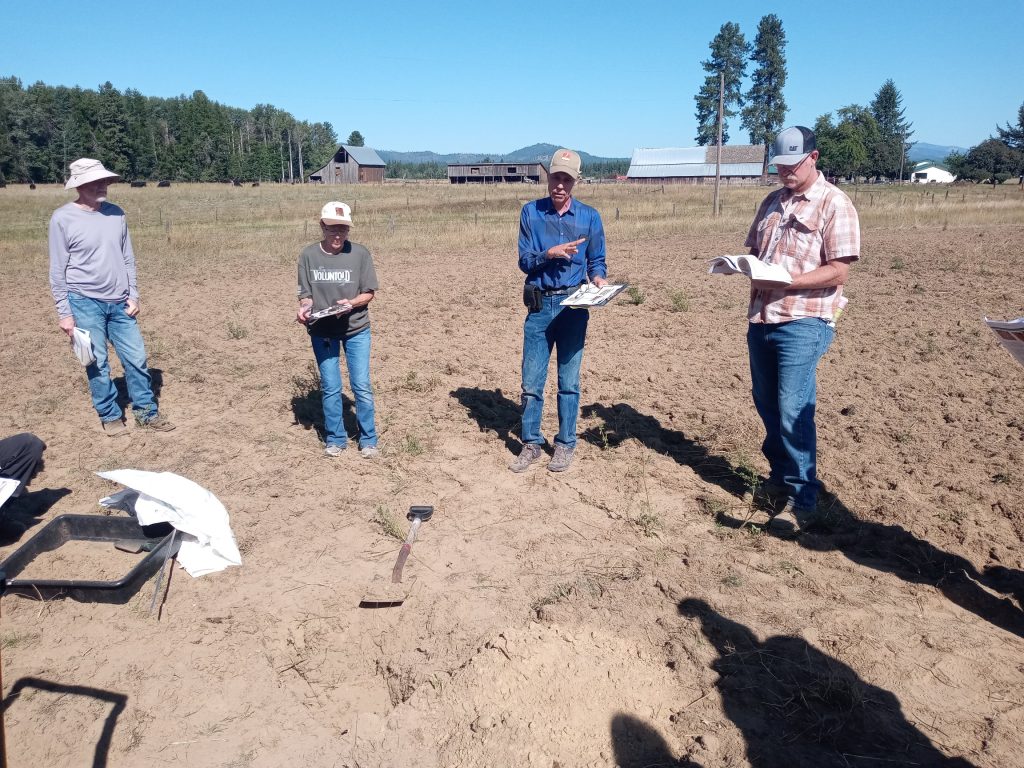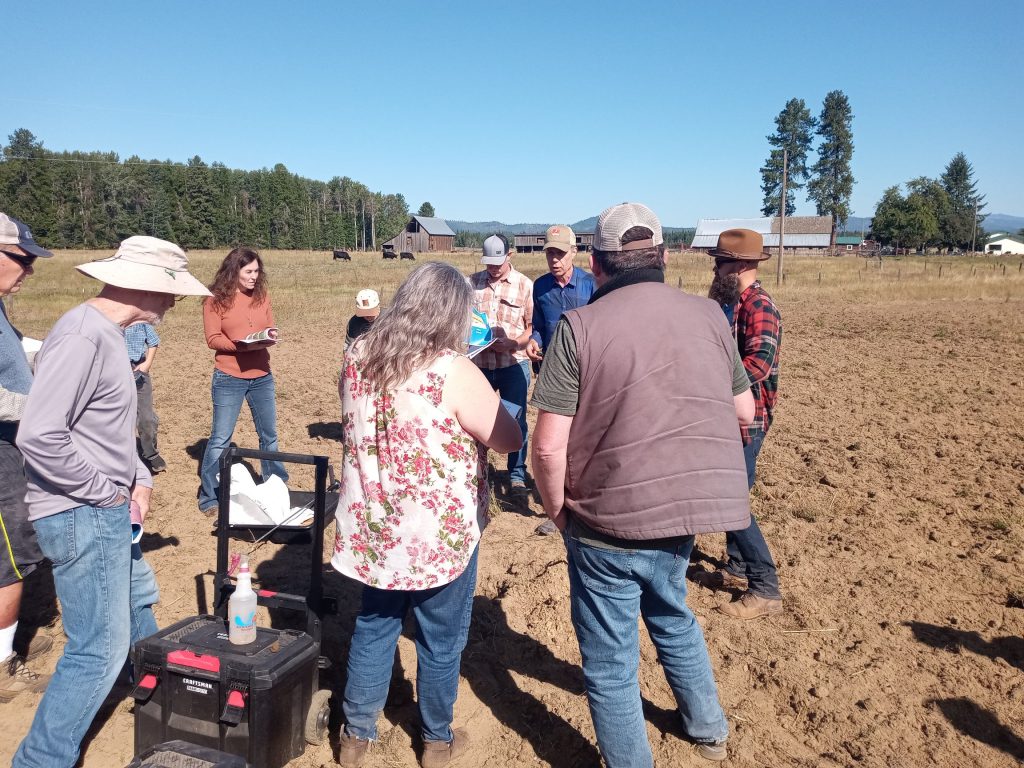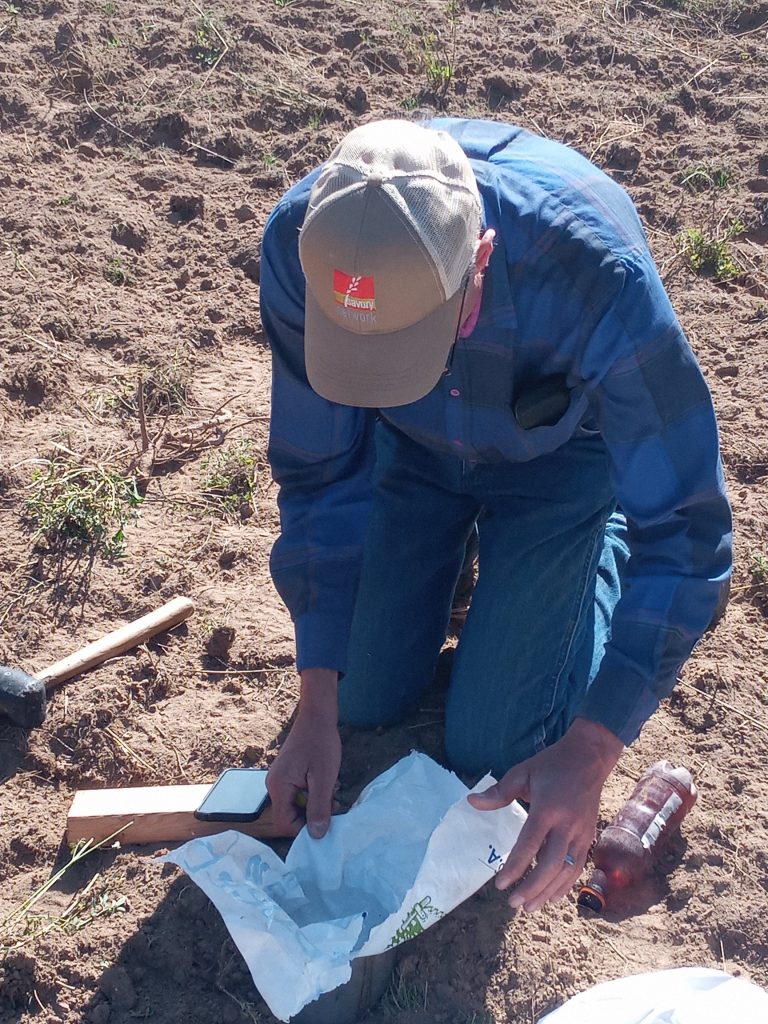On September 9th, the Stevens County Conservation District hosted a Soil Field Day at Vetter Demonstration Farm near Clayton. Craig Madsen, Agroecologist Coach, was the presenter for the workshop. Craig’s first question when we were gathered around a test hole in a just-tilled field was “What is the most important element for plants and animals?” It took a few tries to come up with the answer: oxygen. We both need oxygen. With that we were off into a two-hour program on soil structure.

In the September issue of the North Columbia Monthly I wrote about my own first steps into soil testing and leaf testing. Right off I learned that my soil was too dry. At this workshop I met folks who had much different soil structures: clay, loam, rocks, silt… Their soils could often be too wet and cut off oxygen. The season when you test is a factor. Testing is best done in the spring as soon as growth begins. In the Fall, soil is not as lively. Once you have test results, stick with the same lab. Otherwise, it will be hard to compare changes year to year if the metrics are changing from lab to lab.
I was also under the impression that we would be talking about chemicals and the biology of the soil as a follow-up for me on my recent soil test. I was wrong again. Soil is more like the blind men and the elephant. Looking at chemicals and elements tells you a lot about the soil, but not about structure, and structure tells you a lot but not much about chemicals. Neither one zeros in on the biology in the plant or in the soil. Each approach is a blind man describing the soil elephant.

That oxygen that we all need gets into my sandy soil easily. The soil on Vetter farm had been tilled regularly for years. Tilling loosens up tiny clay particles in the top layer. The clay particles wash down to the untilled level and build up a hardpan that water can’t get through. So, the top layer gets too wet when it rains or is watered. Then it dries out more quickly with no water sinking deep into the soil where roots can bring it up again. Craig pushed a soil probe into the ground and 10 inches or so down it ran into a hard dry clay layer that it could not go through.
There are several ways to open up that clay layer. Plants with big roots such as Diakon radish add organic matter and leave openings for water and air. Deep-rooted plants such as alfalfa can help. Worms do a great job but need the right soil, temperature, and organic matter mix. They don’t do well in sand. A subsoiler can break open the hardpan but tilling needs to stop or hardpan will build up again. One size does not fit all but notice that the plants and animals can heal their home.
We went on to look at how well soil drains; what color it is; how big are the chunks that cling together; how deep existing roots went; if there was a crust on the surface; and what kinds of crops best suited existing conditions. Everyone was hoping for simple solutions that would definitely work. Therein lies the twin trap of reductionism and commercialism. Science has a hard time determining the effect of one factor in a complicated interaction. Was it the weather, the soil, the DNA, the residual chemicals… Reducing a treatment prescription to one answer is bound to be a mistake. Believing that some commercial product promoted by the people who sell that product is going to solve all your problems is also likely to be a mistake. The take-away advice was to go slow. Do things. Maybe do lots of things. But above all else, be observant. Be patient. Soil health, like human health, goes in a direction. Watch how the plants respond.
The opposite of reducing analysis and prescriptions to very limited factors is variety and abundance. Plants, animals, and fungi can all play a role. They offer resilience in that as conditions change, new biology springs into action. Monocrops lack the variety that cover crops provide, even if the main crop, say corn, is growing high, legumes and forbs can thrive beneath it adding nitrogen and feeding fungi which boost water and mineral access. Even just 1% organic matter can add 25,000 gallons of water per acre to a field. The more variety in a cover crop, the more resilience, resistance to pests and compensation for a lack of mineral nutrients it provides. Even underground, fungus likes a complex organic environment. As an underground example, Craig showed us an alfalfa plant’s roots. Normally alfalfa hosts microbes which store nitrogen in nodules along the roots. If the nodules are pink, they are fixing nitrogen. If they are white, they are not, often when mineral nitrogen has been added to the soil directly and the plant neglects to store it. But ammonia and other raw mineral forms of nitrogen leach out of the soil quickly, kill microbes as they go and leave the soil worse than it was before.
The alfalfa plant from Vetter Farm didn’t have nodules of any color. The roots were bare and smooth. What you want to see are “rasta roots”, that is, roots covered in the hair of fine roots and fungal filaments. We were taught to think of “survival of the fittest” meaning that all life forms compete with each other for the same food. In a healthy complex food web, the different organisms thrive symbiotically by converting each other’s waste and extra production into new foods. Early pure chemical analysis of plant nutrition focused on the raw minerals that could be reduced out of organic matter. NPK is an abbreviation for percentages of nitrogen, phosphorous and potassium. Yes, these are important, but plants only take up these minerals when they are bound into organic matter by microorganisms. Adding nitrogen to soil by applying chicken manure compost, an organic waste product, doesn’t “burn” plants and still fulfills their need for nitrogen.
A diverse biome of plants and animals heals its home better than steel tools and raw chemicals. At the end of the day – and the session – there was no silver bullet. We need to earn healthy soil cautiously with attention over time to the results of our actions on our own fields and crops.

